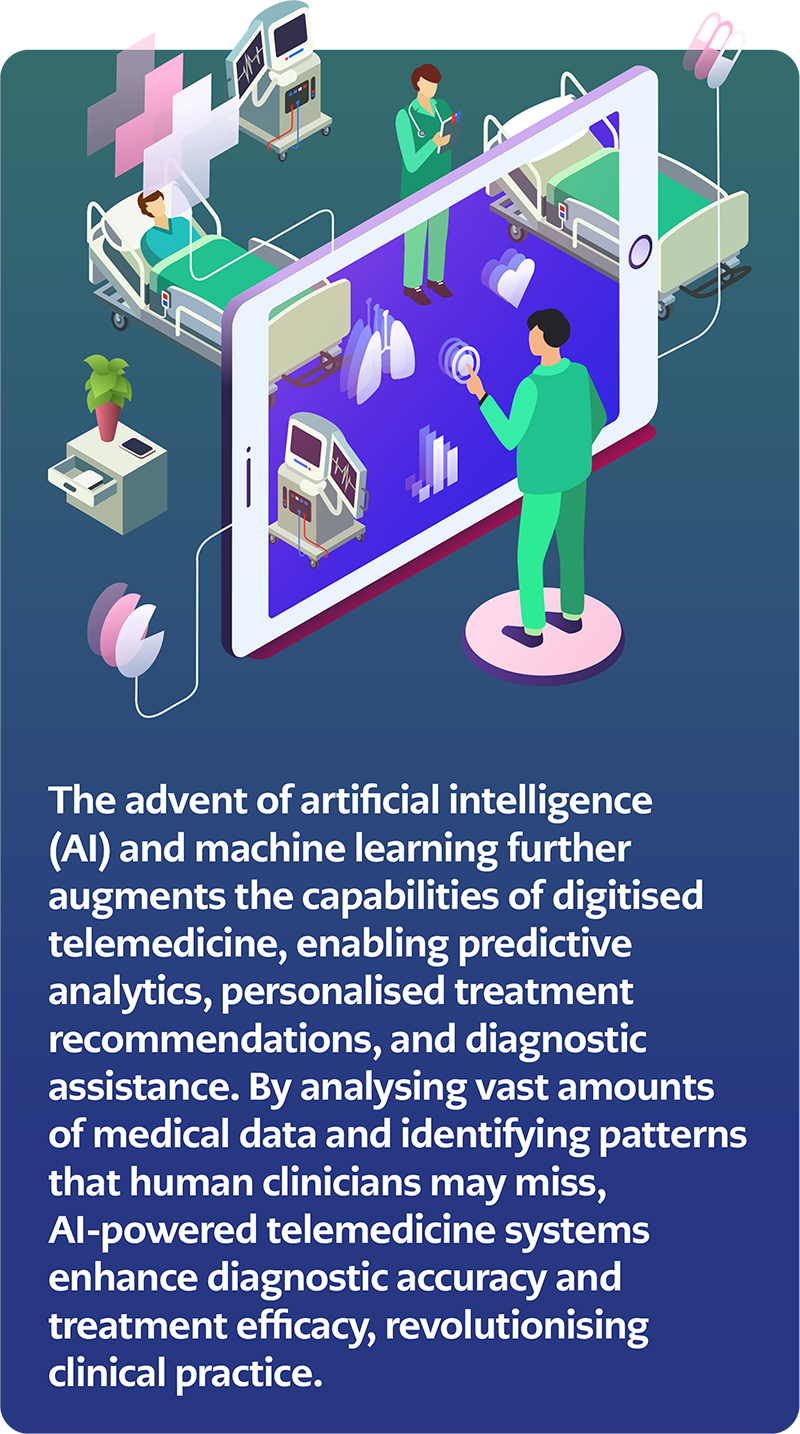The Rise of Digitised Telemedicine: Revolutionising Healthcare Access
The emergence of digitised telemedicine is a testament to this evolution, promising to revolutionise how patients access medical care and interact with healthcare professionals


Telehealth or Telemedicine is a broad term encompassing the use of information and communication technology to share audio, images, or data between consumers and health professionals. This technology is used for various purposes, including health assessment, diagnosis, and intervention, and can potentially transform the healthcare industry.
In an era where technological advancements continually reshape the landscape of various industries, perhaps none have experienced a more profound transformation than healthcare. The emergence of digitised telemedicine is a testament to this evolution, promising to revolutionise how patients access medical care and interact with healthcare professionals. As the world grapples with the challenges posed by the aftermath of the COVID-19 pandemic and seeks innovative solutions to enhance healthcare accessibility, the significance of digitised telemedicine has never been more apparent.
Telemedicine, providing healthcare services remotely through telecommunications technology, has existed for decades in various forms. However, digitisation has propelled telemedicine into new realms, offering unprecedented opportunities to bridge geographical barriers, improve patient outcomes, and streamline healthcare delivery.
One of the primary driving forces behind the widespread adoption of digitised telemedicine is its ability to transcend traditional healthcare constraints. By leveraging digital platforms, patients can now connect with healthcare providers from virtually anywhere, eliminating the need for physical proximity and extensive and sometimes inconvenient travel. This accessibility is particularly advantageous for individuals residing in remote or underserved areas, where access to quality healthcare services may be limited.
Furthermore, digitised telemedicine facilitates timely and convenient access to medical consultations, thereby reducing wait times and enhancing the overall patient experience. Through secure video conferencing, real-time messaging, and virtual consultations, patients can seek medical advice, receive diagnoses, and even obtain prescriptions from the comfort of their own homes. Such convenience improves the patient experience and satisfaction and promotes proactive healthcare management and early intervention.
Moreover, digitised telemedicine holds immense potential to address disparities in healthcare access among vulnerable populations. By breaking down transportation, mobility, and socioeconomic status barriers, telemedicine ensures that marginalised communities have equitable access to healthcare services. This inclusivity aligns with the broader goals of achieving universal health coverage and promoting health equity on a global scale.

Changes in how healthcare was delivered during the pandemic were needed to reduce staff exposure to sick people, preserve personal protective equipment (PPE), and minimise the impact of patient surges on medical facilities.
Because of COVID-19, healthcare systems have had to adjust their methods of triaging, evaluating, and caring for patients, which do not rely on in-person contact.
Beyond facilitating remote consultations, digitised telemedicine encompasses many innovative applications that enhance patient care and clinical outcomes. For instance, remote patient monitoring technologies enable healthcare providers to track patients' vital signs, medication adherence, and disease progression in real-time. This proactive approach empowers patients to take charge of their health and enables healthcare professionals to intervene promptly in case of deviations from optimal health status.

Telemedicine platforms offer integrated solutions for electronic health records (EHRs) and medical data management, ensuring seamless communication and collaboration among healthcare providers. This interoperability enhances care coordination, reduces medical errors, and facilitates informed decision-making, ultimately improving patient safety and clinical outcomes.
However, amidst the rapid proliferation of digitised telemedicine, certain challenges and considerations warrant careful attention. Privacy and data security are paramount concerns, given the sensitive nature of medical information transmitted through digital channels. Ensuring robust encryption protocols, compliance with regulatory standards such as HIPAA (Health Insurance Portability and Accountability Act) and implementing stringent cybersecurity measures are imperative to safeguard patient confidentiality and mitigate the risk of data breaches.
Furthermore, equitable access to telemedicine services remains contingent upon patient digital literacy, internet connectivity, and technological infrastructure. Addressing these disparities requires concerted efforts to bridge the digital divide and ensure that all individuals, regardless of socioeconomic status or geographic location, can harness the benefits of digitised telemedicine.
In conclusion, digitised telemedicine represents a transformative force in modern healthcare, offering unprecedented opportunities to enhance access, efficiency, and quality of care. By leveraging digital technologies to transcend geographical barriers, streamline healthcare delivery, and empower patients, telemedicine holds the potential to revolutionise the healthcare landscape and redefine the patient-provider relationship. As we navigate the complexities of an increasingly interconnected world, embracing digitised telemedicine emerges as a crucial step toward building a more accessible, equitable, and resilient healthcare system for all.
Martin Conboy is well recognised as one of the leading voices in the outsourcing / shared services industry and its role in facilitating outsourcing success throughout the Asia Pacific. In 2014, Martin was voted among the top five most influential and respected people in the global call centre outsourcing industry.



